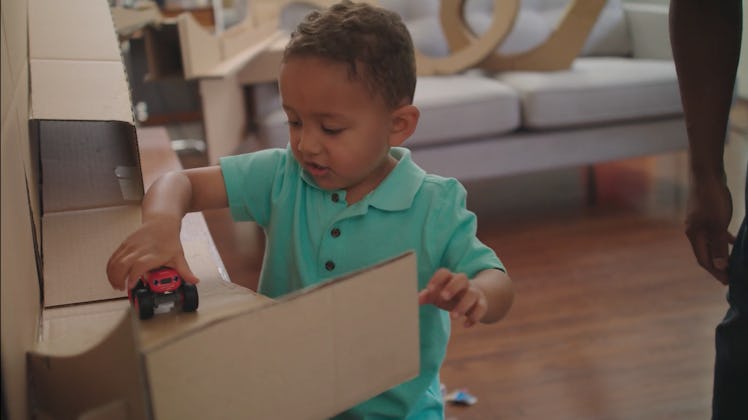How Playing With Toy Trucks Drives Child Development and STEM Learning
Building skills for a driverless future.

The following was produced in partnership with Blaze and the Monster Machines, Nick Jr.’s STEM-based preschool series that entertains, educates, and inspires through playful, adventurous content.
Parents of preschoolers are likely familiar with Blaze and the Monster Machines, the popular animated series about monster trucks that teaches kids STEM lessons likely to serve them well in the not-so-distant driverless future. What parents might not be as familiar with is how to demonstrate those lessons in everyday life. That’s where a very familiar toy comes in.
Toy cars (and trucks) rule. They roll. They race. They crash. They make great booby traps, decent head massagers, and, in a pinch, highly unpredictable street hockey pucks. As it turns out, they also promote kids’ physical and cognitive development. According to play expert Dr. J. Alison Bryant, playing with toy trucks can help kids develop a whole bunch of fundamental skills and better understand STEM concepts.
Dr. Bryant, who founded the leading play industry innovation and development consultancy PlayScience and currently serves as CEO, has spent her career studying and thinking about what makes play healthy, productive, and fun. Between her professional work and her personal “field work” as the mother of two young boys obsessed with all things that roll, including everyone’s favorite animated monster truck, she’s collected a stack of data indicating that toy vehicle play checks all three of those boxes.
How do toy trucks foster cognitive and physical development? By forcing children to exercise gross and fine motor skills. In the simplest sense, kids learn to move things around. They see how quickly or slowly the toys roll and learn about what they can do depending on how much pressure they apply. It’s an early lesson in knowing one’s own strength, although Dr. Bryant cautions parents against assuming that learning how hard to push a toy vehicle will necessarily translate to recognizing how hard to push their little brother. Or not.
Once they move on to opening and closing doors, putting people in the trucks, or moving bits of track around, kids pick up fine motor skills. Then, when they put it all together and start flinging trucks around the tracks and moving things through space, cognitive development happens. “That’s how kids learn,” Bryant says. “Their minds work while they do things with their hands. It’s all integrated. That’s why toy cars are the whole package.” And that’s how STEM learning starts to take root — even if kids don’t realize as it’s happening.
Dr. Bryant has seen that happen in her own life. Last Christmas, she got her youngest son a toy that essentially amounts to a PVC pipe with a window running down one side. (She’s a play scientist — hear her out.) He quickly became obsessed with rolling every toy vehicle he could find down it, watching them zoom past through the window, and adjusting things like the height of the tube or the force of his push to make the toys go faster. “Because of course, that’s always the objective. You’re a kid. You want it to go faster.” (See? Science.) Sure enough, his twin older brothers got in on the action, too. Cognitively, they were making calculations, even if none of them fully understood the physics behind what they were doing — they just wanted to make the thing work better.
The trucks-down-the-tubes example, Bryant says, shows the root of STEM learning. Her kids were learning simple engineering dynamics around velocity and mass (“The heavier car goes down faster”), but, more importantly, they were having their curiosity piqued. Through play, they were learning to interact creatively with those core skills and elements that, eventually, will allow them to ace AP physics.
Tying those lessons in with an element of kids’ daily lives (like, say, an animated series featuring STEM problem-solving monster trucks, for example) sweetens the pot. Blaze offers kids the examples and models for how to play, and some of the verbiage to describe those concepts. The matching toys let them put those concepts into action at home.
“The toy car allows true hands-on learning. You’re not just watching a show and learning about trajectory or buoyancy, but now you’re literally experiencing it,” Bryant says. “It’s the tactile, visual, sensory learning of doing. And we know that, for STEM skills, the best way to learn is through doing.”
In fact, the connection between real life and play is why toy vehicles have stood the test of time. Because while parents do the car seat shuffle every day, their kids are watching from the back and wishing they could drive. Toy trucks let them do that.
“It puts the child’s day-to-day in context when they go from sitting in a car to having the agency to play with one,” Dr. Bryant says. She continues, “My 2-year-old freaks out when he sees a school bus. He brings his toy school bus in the car and rolls it back and forth when the real school buses drive by. He’s seeing something in his real world what he can play with.”
This article was originally published on